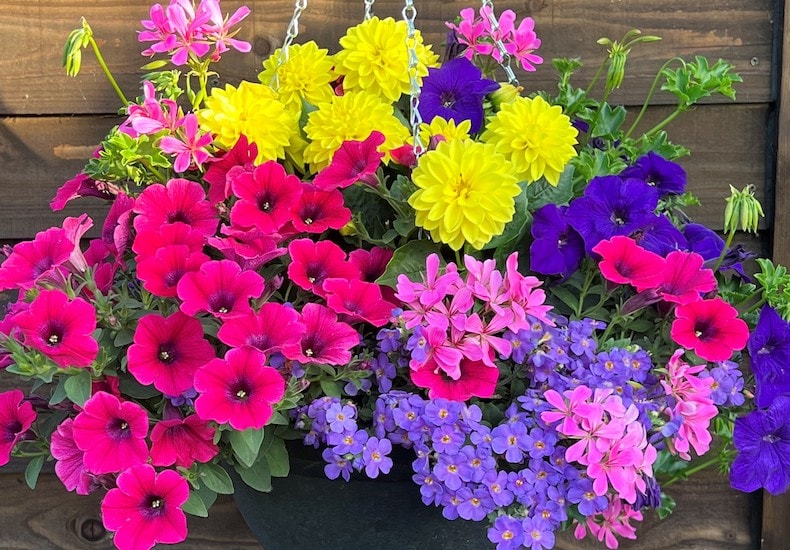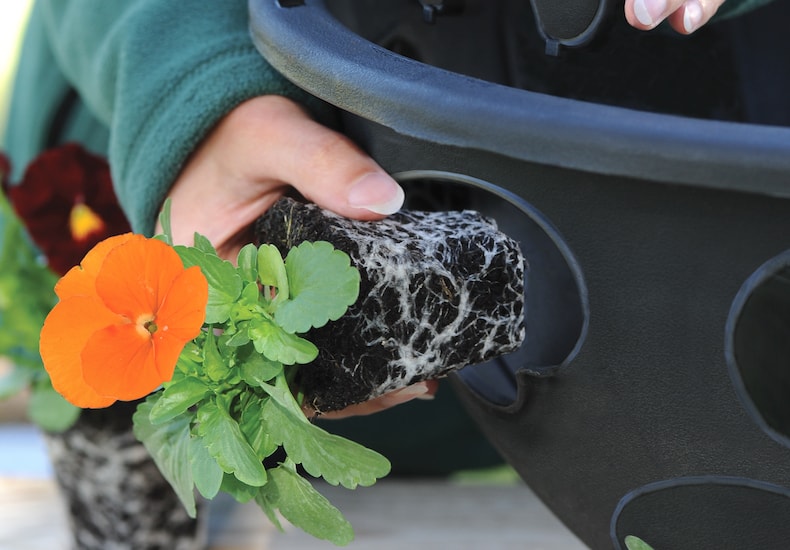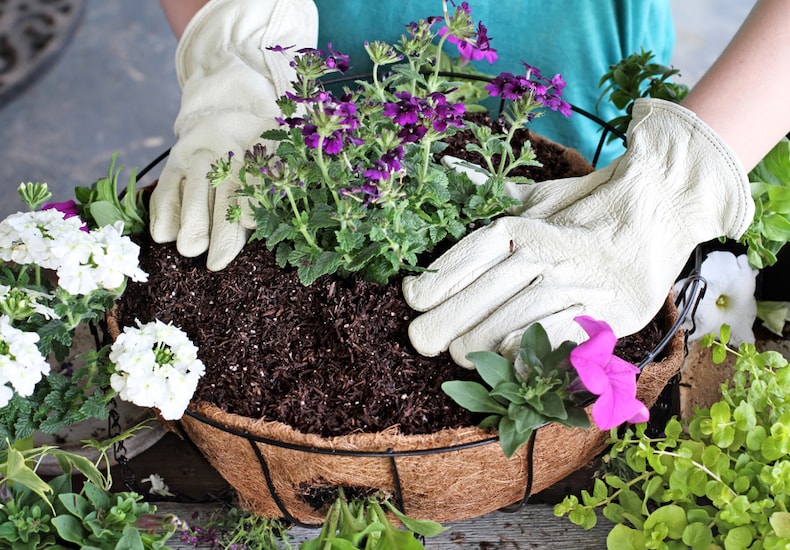How to plant hanging baskets and containers

Pre-planted hanging baskets create beautiful displays of colour
Image: Tutti Frutti Pre-Planted Basket
from Thompson & Morgan
It’s easy to jazz up a bare wall or fence with colourful hanging baskets. You don’t need to stick to flowers either. Why not grow an attractive selection of fresh herbs or a quick growing salad crop in a basket or container close to the kitchen door? Whether you’re making the most of your vertical space or filling empty pots on your patio, here are some practical tips and quick video guides to help you put your hanging baskets to good use through summer and winter.
Browse our full range of hanging basket and container annuals for inspirational colour, structure and scent.
When to plant hanging baskets and containers

BloomAround baskets are easy to re-use, year after year
Image: BloomAround Hanging Basket
from Thompson & Morgan
If you have a greenhouse or can provide frost protection for your plants, you can start planting up your baskets, flower pouches and containers in April. Standing them in a greenhouse for a few weeks allows the plants to reach their full flowering size early in the season.
If you don't have a greenhouse, you should wait until early summer to plant them up, when all risk of frost has passed. Alternatively, put your beautifully planted hanging baskets and containers out into a warm and sheltered spot during the day, but be sure to bring them back under cover at night until the weather warms up and you’re certain they won’t succumb to frost.
During this period, turn the baskets each day to ensure even growth, deadhead the flowers as they fade, and pinch out the growing points of any long, straggly plants to encourage them to bush out.
Types of hanging baskets and liners

This classic black metal hanging basket is supplied with a high quality coco husk liner
Image: Garden Grow Hanging Basket & Liner from Thompson & Morgan
Traditional mesh hanging baskets are made of plastic-coated wire, although reusable plastic hanging baskets are also available. If you’re using a wire hanging basket, you’ll require a liner to contain the compost and plants. The cheapest option is inexpensive sheet plastic which can be cut to size and disguised by a layer of straw or hessian. You’ll need to cut slits in the sides of your liner if you want to feed trailing plants through.
For a quick and easy solution, you can buy coco basket liners to drop into your wire frames. To save time and dispense with the need for liners altogether, why not try our Easy Fill hanging baskets with pre-cut ‘gates’ around the sides for your plants to cascade through?
How many plants do I need for hanging baskets and patio containers?
A general rule of thumb for hanging baskets is to use one plant per inch of basket diameter – so 12 plants per 30cm (12 inch) hanging basket.
The only exception to this is when you use strong-growing plants such as fuchsias and geraniums (pelargoniums). For these varieties, you’ll only need to use 5 plants per 30cm (12 inch) hanging basket.
| Plant | 22cm (9") basket | 30cm (12") basket | 30cm (12") patio container | Eezee Patio Bag | Flower Tower |
|---|---|---|---|---|---|
| Aubrieta | 3 | 4 | 4 | 10 | 16 |
| Begonia (fibrous, e.g. Organdy) | 6 | 10 | 8 | 10 | 32 |
| Begonia (tuberous, e.g. Apricot Shades) | 3 | 5 | 5 | 10 | 21 |
| Bellis | 6 | 10 | 8 | 10 | 32 |
| Bidens | 5 | 7 | 5 | 10 | 32 |
| Busy Lizzies | 4 | 10 | 8 | 10 | 32 |
| Sunpatiens | n/a | n/a | 5 | 10 | 32 |
| Carnation (trailing) | 6 | 10 | 8 | 10 | 21 |
| Fuchsia (upright) | 3 | 5 | 5 | 10 | 16 |
| Fuchsia (trailing and semi-trailing) | 3 | 5 | 5 | 10 | 16 |
| Geranium (bedding Pelargoniums) | 3 | 5 | 5 | 10 | 32 |
| Geranium (trailing Pelargoniums) | 3 | 5 | 5 | 10 | 16 |
| Lobelia | 8 | 12 | 10 | 10 | 32 |
| Pansy and Viola | 6 | 10 | 8 | 10 | 32 |
| Petunia (trailing) | 3 | 5 | 5 | 10 | 16 |
| Primrose and Polyanthus | 4 | 7 | 7 | 10 | 32 |
| Sweet Pea (trailing) | 5 | 12 | 10 | 10 | 32 |
| Verbena (trailing, e.g. Union Jack Mixed) | 3 | 7 | 7 | 10 | 32 |
Step-by-step guide to planting hanging baskets

Trailing plants can be fed through holes in the sides of your basket
Image: Stephanie Frey/Shutterstock
Here’s a step-by-step guide to planting up your hanging basket:
- Start by placing your empty hanging basket on a bucket so it’s held firmly in place whilst you add the plants.
- Adjust your chosen liner so it fits the basket snugly. Trim off any excess material that protrudes above the rim. Using sharp scissors, make a series of 5cm (2 inch) slits in the sides of the basket liner to accommodate trailing plants. The trailing plants will eventually fill out and mask the wire frame. If the basket is deep enough, two layers of slits can be placed around the basket.
- Create a compost mix by adding 20% perlite to a good quality multi-purpose compost. It’s also a good idea to mix in some water-retaining granules and slow-release fertiliser to prevent baskets drying out quickly, and to feed plants through the summer season.
- Fill your basket with the compost mix until it’s level with the first layer of slits and gently firm down.
- Insert your trailing plants by pushing the plants 'head-first' from the inside through the slits. To protect delicate young growth, try wrapping your plant loosely in polythene whilst you guide them through the holes.
- Continue to plant until all the slits have been filled, and then gently tease out the roots of the plants. Add more compost and work it around the roots of the plants until the basket is almost full. Leave a 5cm (2 inch) gap below the rim.
- Plant further trailing plants around the top of the rim. Your basket will look fuller if you stagger them so that they’re in between the plants below.
- Choose a bushy upright plant for the centre. Fill in around the roots with further compost mix; aiming to keep the soil surface an inch below the rim of the basket to prevent compost spilling out when watering.
- To finish, water your hanging basket thoroughly with a fine-rose watering can and stand it in a greenhouse to grow on. If you don't have a greenhouse and your basket contains half-hardy plants, you’ll need to bring your basket under cover each evening to protect it from frost.
Moving hanging baskets and containers outside

Choose a sturdy bracket to hold the weight of your basket
Image: Hanging basket wall bracket 25cm x 36cm from Thompson & Morgan
Hanging baskets, containers and flower pouches should be placed in their final position once all risk of frost has passed. If your hanging basket or container has been living in a warm greenhouse, be sure to harden the plants off for a week before placing them permanently outside.
Use a strong bracket to hang your basket. Provided your plants aren't shade-loving, choose a sunny and warm location, preferably south-facing so your baskets and containers receive full sun all day. Turn the baskets regularly and try to avoid windy sites if possible.
Due to the volume of plants in hanging baskets and containers, they dry out very quickly in fine weather so keep an eye on the soil and water if the top half-inch of compost feels dry. Some plants like lobelia don’t recover if they become too dry, so take care! Watering in the evening helps to reduce evaporation.
Planting fruit, vegetable and herb hanging baskets

Strawberries look lovely in a hanging basket, and it keeps them clear of the slugs!
Image: Shutterstock
While flowers look beautiful, why not try growing your own vegetables and herbs in a hanging basket? Ornamental and edible, you can grow all sorts of fresh produce this way. Many herbs and vegetables have beautifully coloured leaves, seed pods or fruits, so choose crops that look as good as they taste.
When lining a fruit or vegetable basket, always choose sheet plastic or polythene to help with water retention - it’s essential that they don’t dry out. Also, vegetables and herbs do need more space than bedding plants. For example, you only need 3 trailing tomato plants per 35cm (14 inch) basket or container. Bush cucumbers become quite large, so 1 plant per basket or container would be sufficient. Position your basket or container in a sheltered, sunny site, although herbs and cucumbers do appreciate some shade.
The best vegetables for hanging baskets and containers include:
- Cucumbers such as ‘Goblin’
- Chilli pepper plants
- Cut-and-come-again lettuce such as ‘Salad Bowl’
- Tumbling tomatoes like ‘Tumbling Tom Red’
- Strawberry plants
- Peas and dwarf bean plants
- Parsley
- Basil
- Sage
- Chamomile
- Chives
- Marjoram
- Sorrel
- Thyme
Planting winter and spring hanging baskets
Hanging baskets and containers aren’t just for summer displays. They’re just as effective in brightening up a winter or spring garden. Watch our helpful video guide to learn how to plant up an easy fill hanging basket for winter.
Good perennial plants for winter hanging baskets and containers include dwarf conifers, Euonymus, dwarf Hebes, Cordylines and Heuchera, which all provide structure.
Heathers, Thyme and Gaultheria procumbens are evergreen plants with good spreading habits. Small varieties of grasses such as Carex flagillifera and Carex comans will spill over the sides of a basket or container providing a trailing effect. Other good trailing plants include ivy and periwinkle (Vinca). For colourful flowers try Cyclamen, polyanthus and winter pansies.
We hope we’ve inspired you to put your hanging baskets to good use, all year round. For even more helpful information on how to plant and grow hanging baskets, check out our dedicated hub page where you’ll find articles, videos and the best plants to try.

Written by: Sue Sanderson
Plants and gardens have always been a big part of my life. I can remember helping my Dad to prick out seedlings, even before I could see over the top of the potting bench. As an adult, I trained at Writtle College where I received my degree, BSc. (Hons) Horticulture. After working in a specialist plantsman's nursery, and later, as a consulting arboriculturalist, I joined Thompson & Morgan in 2008. Initially looking after the grounds and coordinating the plant trials, I now support the web team offering horticultural advice online.Sign Up For Exclusive Special Offers




© 2024 Thompson & Morgan. All rights reserved. A division of Branded Garden Products Limited.



